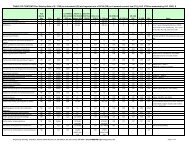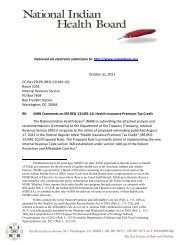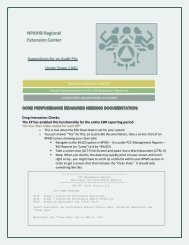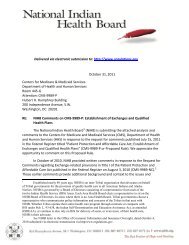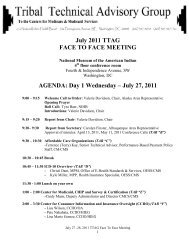mmpc - National Indian Health Board
mmpc - National Indian Health Board
mmpc - National Indian Health Board
Create successful ePaper yourself
Turn your PDF publications into a flip-book with our unique Google optimized e-Paper software.
Conclusions and Recommendations<br />
IHS AIAN Payments Compared to Others<br />
There is no evidence on a national basis that Medicaid per capita payments for the AIAN user population of IHS<br />
Programs (IHS AIAN) in 2006 are lower than for other Medicaid recipients. Overall in 9 of the 12 IHS Areas<br />
Medicaid payments for personal health care services of IHS AIAN were as high as or higher than either selfdeclared<br />
AIAN who did not use the IHS health care system and of whites living in the same counties. The<br />
exceptions to the general finding in four IHS Areas were: In Albuquerque Area the per capita payments overall<br />
were higher than those of self-declared AIAN who did not use the IHS system, but not higher than Whites. In<br />
Oklahoma Area the payments were higher than for Whites, but not the AIAN who did not use the IHS system. In<br />
Aberdeen and Billings Areas the payments were lower for most types of IHS AIAN Medicaid recipients analyzed<br />
when compared to other AIAN or whites. For the Nashville Area the conclusion requires acknowledgment that<br />
the Medicaid total payments are higher because Third Party payments for Medicaid claims were included in the<br />
total per capita payment analyzed for all the IHS areas. In the Nashville Area the contribution to the total per<br />
capita payment for Medicaid claims due to private insurance is substantial. Nashville Area also was unlike other<br />
Areas in the large number of states that do not report any IHS Program claims. Nashville Area has many states<br />
and counties, but many states have IHS system providers with small numbers of Active Users. These state<br />
Medicaid programs when interviewed were more likely to acknowledge in 2010 they had no special activities to<br />
identify IHS or tribal provider Medicaid claims (Korenbrot and Crouch, 2010).<br />
In the Tucson, Navajo and Phoenix Areas the payments for the AIAN user population of IHS Programs were<br />
highest, which was found to be attributable to the payment levels in the state of Arizona. When Medicaid<br />
recipients in Arizona were excluded, the AIAN payments for Navajo and Phoenix Areas relative to other AIAN<br />
and whites became more like those in other Areas (the Tucson Area is entirely within Arizona and could not be<br />
analyzed with the exclusion of Arizona Medicaid recipients).<br />
In making these comparisons, payments for six different types of Medicaid service recipients were analyzed.<br />
Medicaid recipients were classified depending on whether they were under age 65 or not, enrolled all year in<br />
Medicaid or not, and whether they received only fee-for-service (FFS) medical care or had any of their medical<br />
services in managed care. The payments for each type of Medicaid recipient were risk-adjusted for differences<br />
between the IHS AIAN and comparison groups with respect to age, sex, disability, and dual-enrollment with<br />
Medicare. Adjustments for differences among the groups in morbidity were possible for those enrolled all year<br />
in Medicaid, but not those enrolled less than a year. The payments were also adjusted for variation in health<br />
care prices across the IHS Areas whether analyzed as mean payment per year for recipients enrolled all year, or<br />
mean payment per month for when recipients were analyzed regardless of length of enrollment.<br />
The findings were not found to depend on any particular type of Medicaid recipient analyzed. For any given<br />
Area one or more of the recipient types the AIAN user population might have an adjusted mean per capita<br />
payment higher or lower than a comparison group. One of the implications of this finding is that the overall,<br />
results did not depend on whether the payments were adjusted for differences in morbidity or not, or whether<br />
they received their medical care in a FFS or managed care system.<br />
The IHS AIAN FFS per capita payments were dominated by outpatient services (including claims for clinic,<br />
medical care practitioners, laboratory and imaging, and dental services). Inpatient payments were a small<br />
41





